Tod Browning’s Sideshow Shockers (1925-1932)
Three twisted pre-Hays Code shockers from filmmaker Tod Browning, early Hollywood's edgiest auteur.
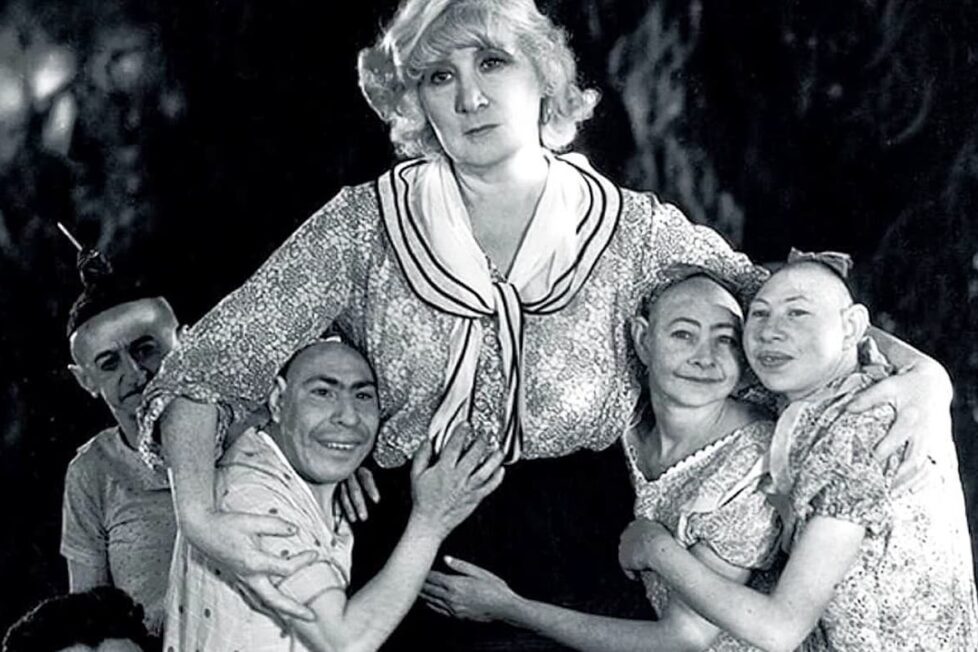
Three twisted pre-Hays Code shockers from filmmaker Tod Browning, early Hollywood's edgiest auteur.


Charles Browning Jr. ran away from home to join the circus when he was 16. He learnt the ropes while working menial tasks, eventually becoming a spieler and creating sideshow performances for more than one carnival company. His acts ranged from song-and-dance routines to slapstick physical comedy, and he became known as ‘The Living Hypnotic Corpse’ for an act involving a live burial inspired by the works of Edgar Allen Poe. It was around this time he took on his professional moniker, Tod Browning, because ‘tod’ is the German word for death…
Browning then ran away again, this time from a comparatively settled life, leaving his wife behind to join touring vaudeville theatre companies. It seems he turned his hand to nearly every genre of live entertainment with a penchant for the macabre, training as a contortionist, an escapologist, and a magician. He performed as a comedian, a blackface minstrel, and presented sensational novelty acts in the sideshow style.
He began acting in front of a camera around 1909 when he adapted some of his comedy antics for a budding director at the Biograph production company, David Wark Griffith. In 1913, Tod would follow the director, better known simply as D.W Griffith, to join the nascent West Coast movie industry that was setting up on the outskirts of a small village with a reputation for its hospitality, called Hollywood. Browning continued acting in short films as well as writing them and, while Griffiths was busy directing his first feature, the infamous epic The Birth of a Nation (1915), Browning also made his directorial debut with The Lucky Transfer (1915). By then he’d appeared in around 50 films but, apart from a couple of later cameos, would concentrate on writing and directing for the rest of his career.
As a jobbing director, Browning’s output was varied, though he tended to favour crime thrillers and melodramas whilst pushing toward the stranger stories when the opportunity presented itself. He eventually became best remembered for Dracula (1931) which was a box office hit, well-received by critics, and instigated the whole Universal Monster genre.
The extensive knowledge and experience from his sideshow and vaudevillian days would repeatedly resurface and circus folk, travelling shows, hypnotism, conjuring–and yes, freaks—would increasingly inform the visual identity of his films. The three Browning classics presented in this definitive Blu-ray box set from Criterion are well-selected examples of his recurring motifs that some may call obsessions—two lesser-known yet excellent examples made before Dracula, and one made later that killed his career…
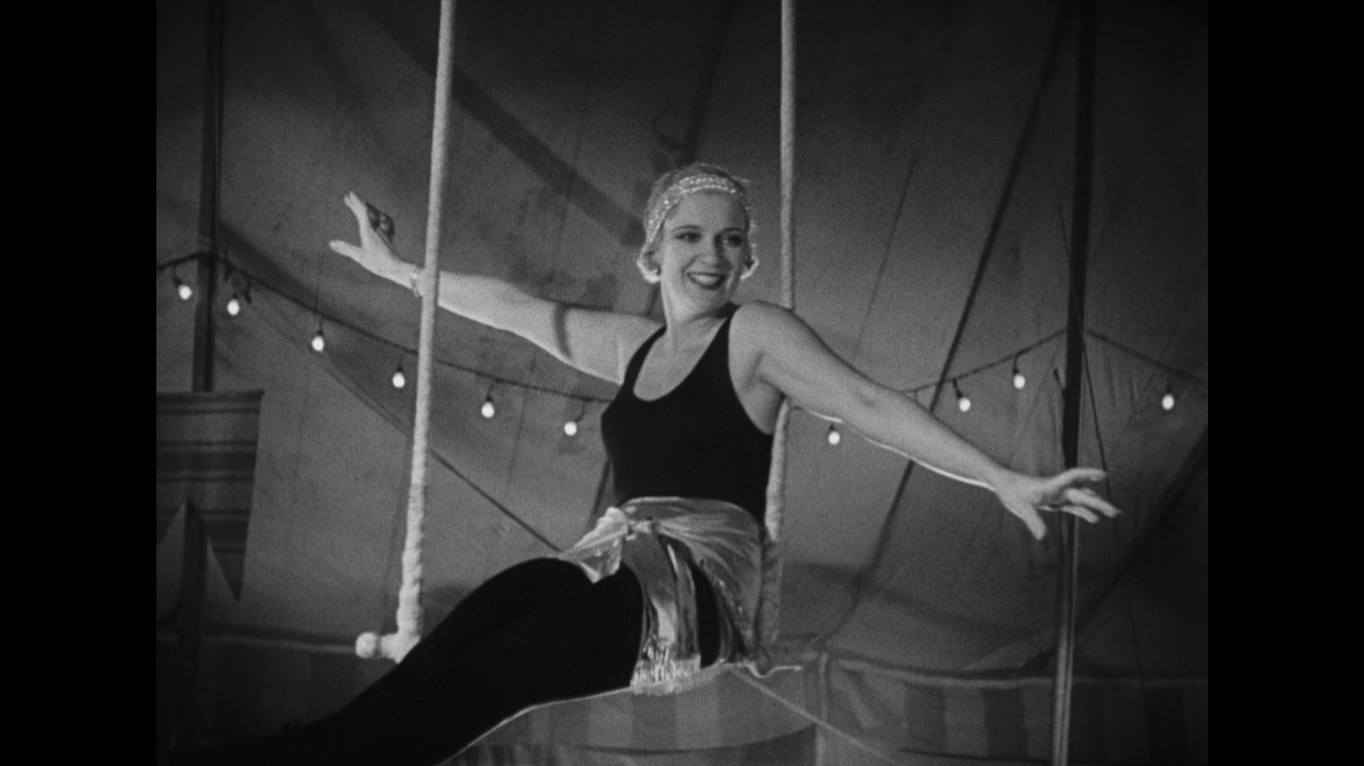

A circus’s beautiful trapeze artist agrees to marry the leader of sideshow performers, but his deformed friends discover she’s only marrying him for his inheritance.
There are two distinct versions of Freaks: Tod Browning’s original, which was never released, and MGM’s theatrical version, which was a drastic rehash in response to the indignation of test audiences. Sadly, the former is the only version to survive, as by all accounts it’s the least remarkable—and that’s saying something! Freaks is now more than just a movie, accruing infamy over the decades and building up its own Hollywood folklore. Most people know of the film even if they’ve never seen it and, in the UK, it’s mostly remembered for an outright ban that stood for 30 years until finally being granted a certificate ‘X’ in 1963, when it was shown on just a handful of screens with little or no fanfare. And that’s one way to create a cult movie.
The ban by the British Board of Film Classification (BBFC) was more a judgement on human nature than of the film’s content. As explained on their website, “it was felt that the film exploited for commercial reasons the deformed people that it claimed to dignify,” and would attract an audience mainly interested in the spectacle of those “deformed people.” Regardless of Tod Browning’s noble intent, it was feared that the better-informed audiences of the progressive 1960s would, nevertheless, come to be entertained, or horrified, by the human oddities on display—just as they would at an old sideshow. It’s still difficult to discuss without using contentious terminology, and for this review, I’ll be using the pejorative ‘freaks’ with no intentional prejudice, but simply to collectively refer to the ensemble of sideshow performers that takes the title role.
Freaks remains a disconcerting experience for different reasons for audiences of different eras. Context is everything here but, although it unashamedly tackles important themes, it isn’t a great movie. For the most part, the screenplay is terrible and rife with heavy-handed expositional dialogue. Perhaps that’s to be expected as dialogue was a relatively new element for cinema to handle. However, it’s redeemed by the moments when a single line unexpectedly hits a deep emotional core. Particularly when delivered by Daisy Earles, who proves herself a gifted actress as Frieda.
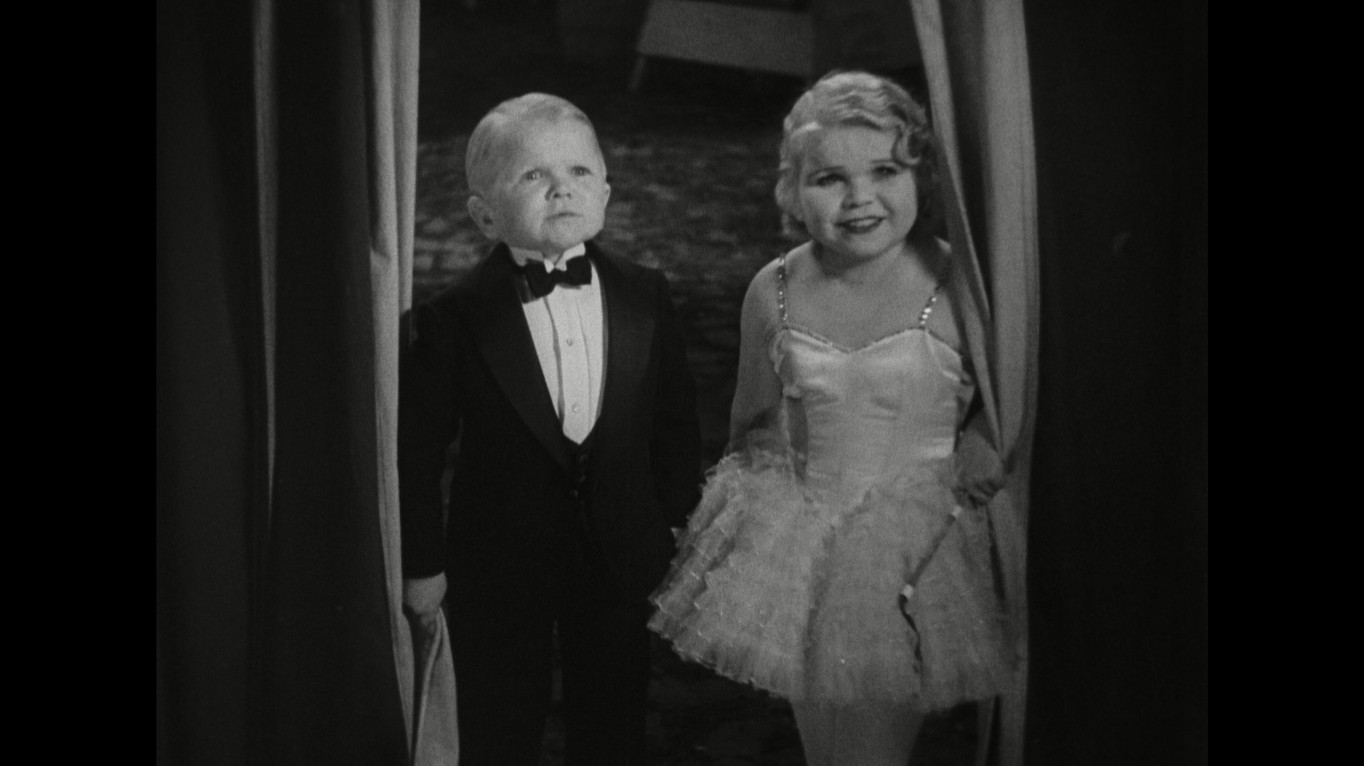
For me, the first and last few minutes are the cleverest, demonstrating Browning’s grasp of cinematic language. To begin with, the opening scene of a sideshow is revealed when the title card, referencing a circus poster, is torn down as if the screen itself has been ripped away; an explicit breach of the fourth wall right there at the start, tearing down a barrier between ‘us’ and ‘them’. After the ‘spieler’ discards the crumpled poster, he delivers his introduction to the onscreen gathering of gawkers that we have joined. Thus, the audience is drawn into the world of the sideshow, initially as outsiders, trying to glimpse whatever is in the pit they surround… and that reveal will be held back until the dénouement.
From this sideshow, we move on to the main attraction in the big top where the glamorous trapeze artist, Cleopatra (Olga Baclanova), performs high above the strongman act as Hercules (Henry Victor) wrestles a bull to the floor. They’re watched from the wings by Frieda and Hans (siblings Daisy and Harry Earles). These establishing shots play with viewer expectations and perceptions. On the screen, the trapeze artist high up and far away seems tiny and doll-like, whereas Hans and Frieda are larger than life, filling the screen. The only thing to give us a comparative scale is a horse in the background, and only when Frieda approaches the animal do we realise it’s a small pony as we see other circus hands in the shot and understand just how tiny Hans and Frieda are.
From their dialogue, we gather they’re engaged but Frieda worries that Hans has eyes for Cleopatra, who he admits is “the most beautiful big woman I have ever seen” but goes on to reassure Frieda she shouldn’t be jealous. However, in the next scene, Cleo clearly understands how Hans feels about her and taunts him by letting her shawl fall, but not bending low enough for him to help her slip it back on when he offers. Realising she’s slighting him he states, “I am a man, with the same feelings.” A double-edged line as he could simply be saying that she can hurt his feelings or maybe implying that he knows she knows he fancies her. This recognition that differences in physical features—and mental abilities in some cases—don’t indicate any lack of emotional faculties is the central theme and will be stridently reiterated throughout.
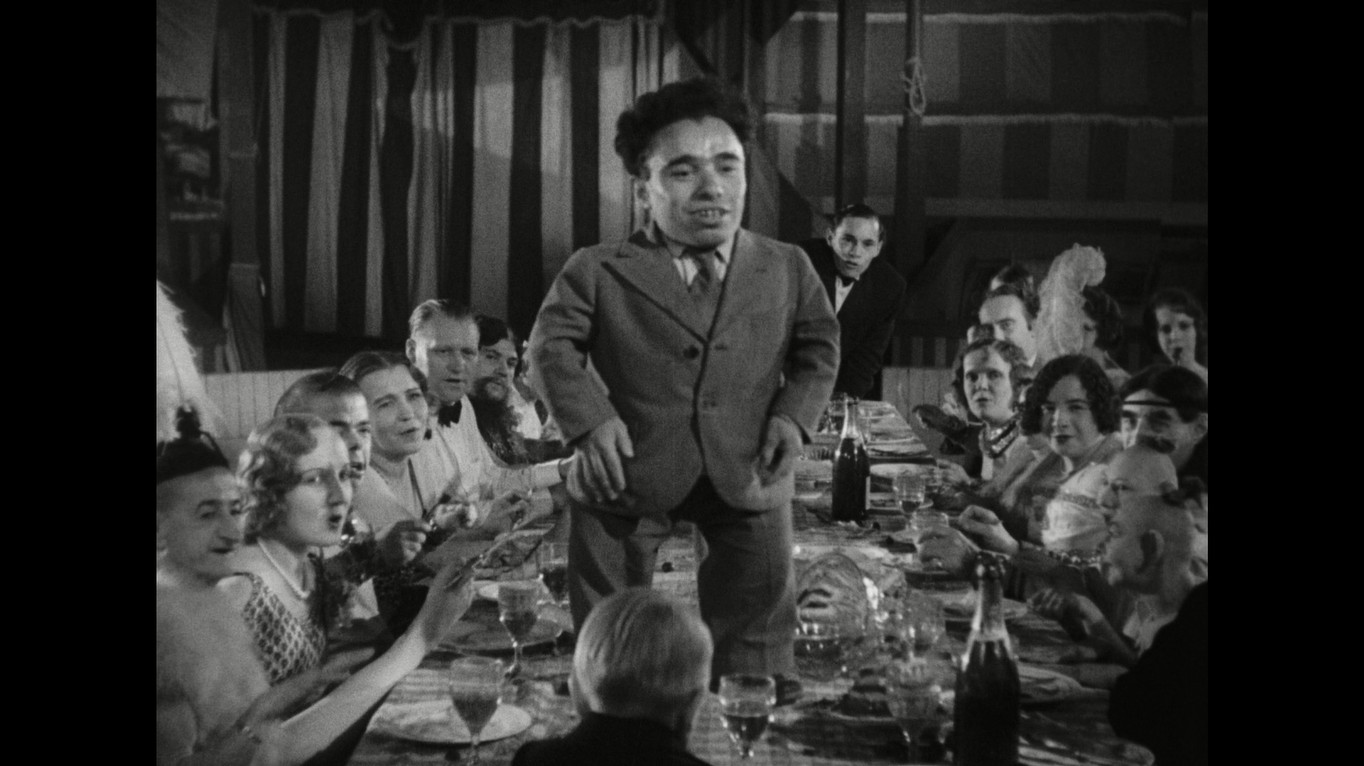
The love triangle between Hans, Cleopatra, and Frieda is the central narrative and even more emotionally excruciating as we’re privy to Cleo’s cruel intentions. She’s learnt that Hans is to be the beneficiary of a huge family fortune and he plans to leave the circus and start a new life with Frieda. So, aware that Hans fantasises about her, Cleo manipulates his feelings, drives a rift between him and his fiancé, coaxes him into a sham wedding and sets about slipping poison into his food and medicine. All this in cahoots with Hercules whom she intends to marry after inheriting Hans’ fortune. How dastardly is that!
Under their athletic and ‘beautiful’ exterior, Cleopatra and Hercules are monstrous. It is they, not the freaks, who’re the true ugly ones here. Many of the able-bodied characters are shown to be malicious and unnecessarily cruel including circus owners, The Rollo Brothers (cameos for prolific character actors, Edward Brophy and Matt McHugh) but it’s not quite that simplistic.
For half a century, scholars have extensively analysed Freaks in many convoluted semiotic treatises, so there’s a wealth of academic literature out there. Many approach the movie as a metaphor that can apply to the discussion of any societal divide, including the class rift between the rich and poor that was widening as the US entered the Great Depression. While most of the papers discussing the socio-sexual aspects are fascinating, they often come across as boffins merely using the film as a convenient vehicle for off-loading their own thesis. This is understandable because there aren’t so many examples out there that touch upon such varied and relevant subtexts.
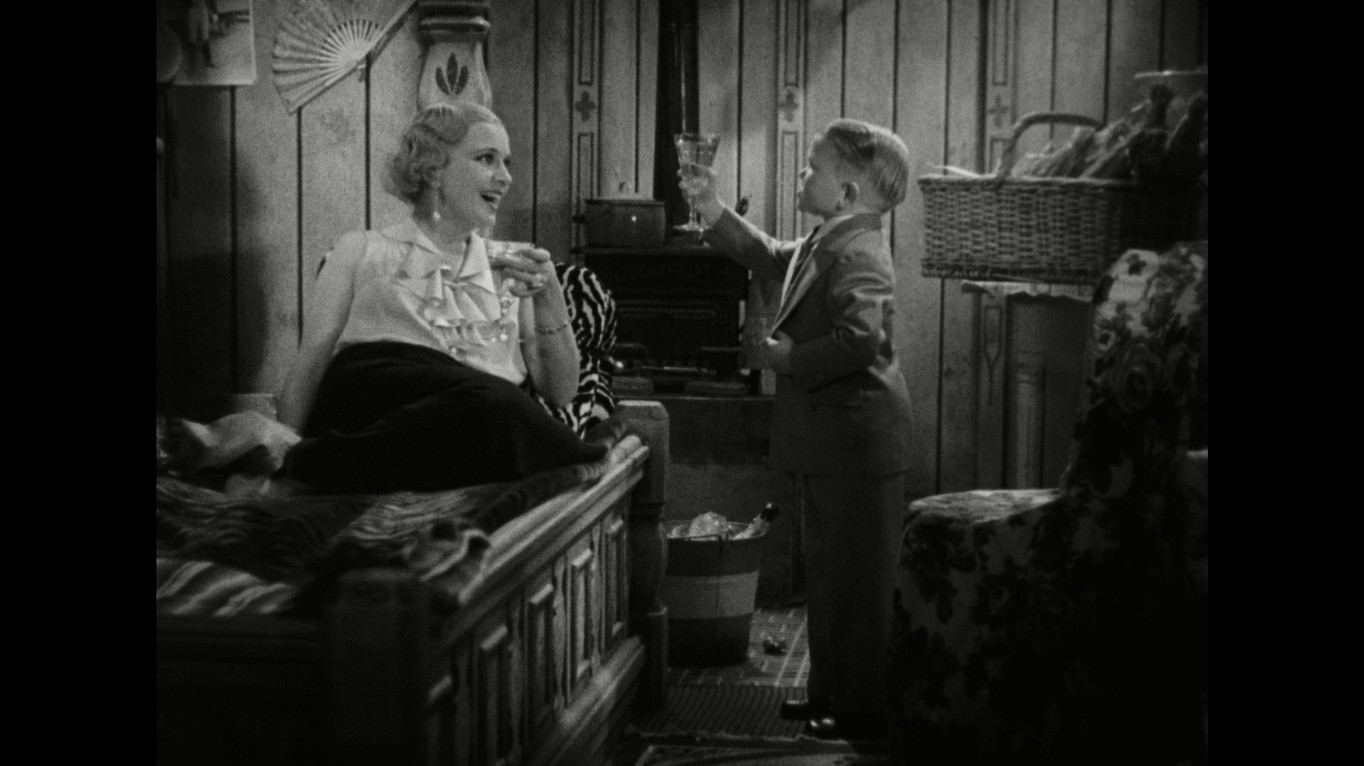
The dialogue repeatedly emphasises that the freaks have normal human emotions and feelings, but we’re not only told but shown this through gendered interactions. We know, right at the start, that Hans and Frieda are to be married, though their love is to be sorely tested. Later, it’s implied that Hans has a relationship with the tall and glamorous Cleopatra and, though the legitimacy of any ceremony is questionable, they are married. However, the script makes it clear that Hans is incapacitated before consummation can occur. That would’ve been too transgressive on many levels—even for the pre-Hays Code 1930s.
There has been much discussion around Josephine-Joseph, the hermaphrodite character, and how her presence disrupts notions of binary categorisation such as normal-abnormal, able-disabled, male-female. We have the able-bodied, ‘normal’ circus performers, and those with varying degrees of disabilities performing as sideshow freaks, their perceived ‘abnormality’ defining them. They are dressed and presented in ways that emphasise those differences. Then we have the division of male and female in the cast who play to their gender roles: Hans has the ‘normal’ feelings of a man; Frieda is performatively feminine in doll-like clothes; the bearded lady gives birth; the strongman wrestles bulls and abuses women.
The scene where Josephine-Joseph is caught watching the gendered interactions of Hercules and Cleopatra is an interesting one and efficiently confronts the socio-sexual hang-ups of the era which even today seem, sadly, unresolved in our supposedly fair and tolerant society. Firstly, Josephine-Joseph appears to be voyeuristic, looking in on an aspect of life that she feels excluded from.
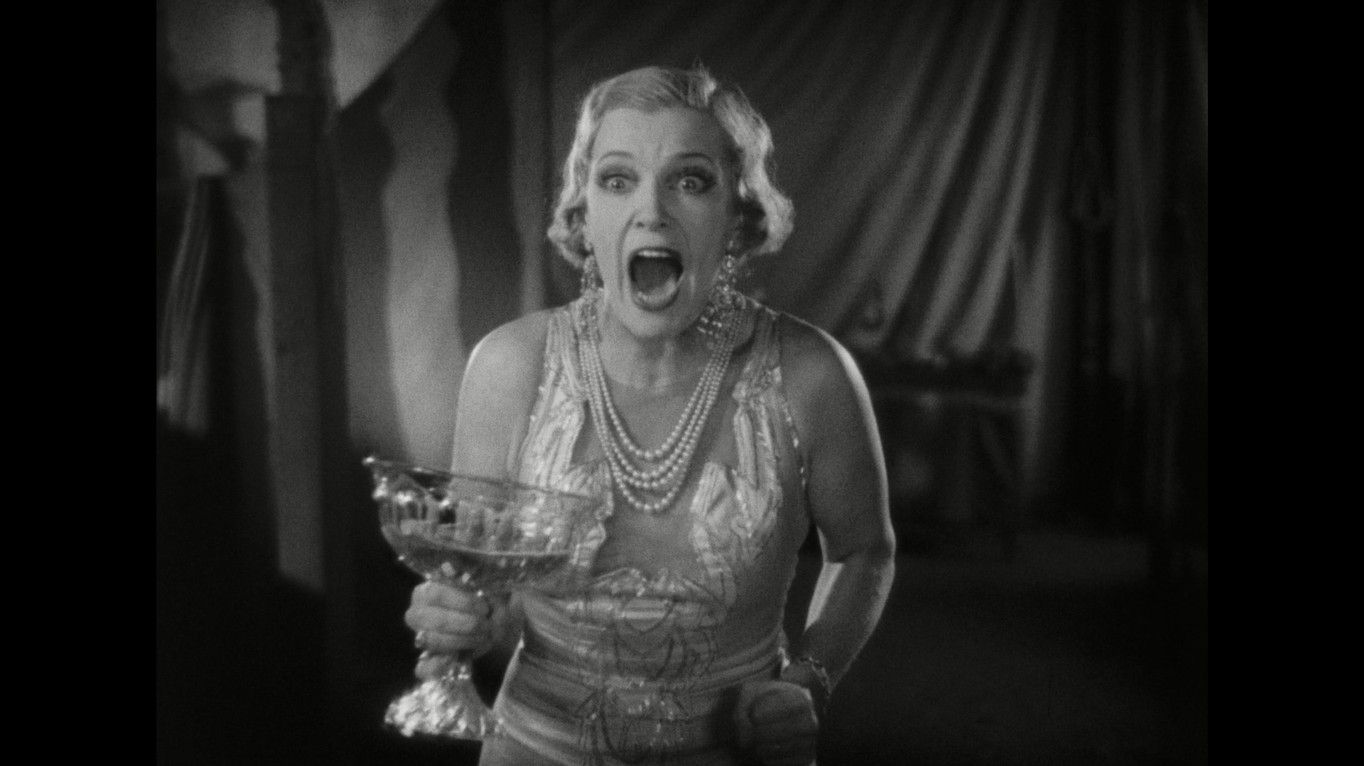
Is she envious? Of their stereotypical normality or, perhaps, their clearly defined dimorphism. Does she simply seek titillation as a ‘peeping tom’? If so, is she attracted to either Cleopatra or Hercules… or both? Is she already suspicious of the couple and their intentions? Does she hope to eavesdrop on a conspiratorial liaison? Or does she simply pause at the door the couple have neglected to close? Whatever the scenario, Hercules is enraged by the bisexual gaze and reacts violently, punching Josephine-Joseph, very hard, knocking her to the floor.
The scene demonstrates the internal, emotional deformity of Hercules and Cleopatra, whose reaction is to guffaw in support of the performative machismo and the injury it causes. As well as confirming the duo as the villains of the piece, there’s so much to unpack for long discussions about what drives gendered violence. Though Josephine-Joseph is a relatively minor character, she’s positioned as a disrupting factor. Interestingly, her representation as half-man-half-woman literally embodies a binary gender whilst explicitly challenging those very concepts. She has a foot in each camp, so to say, in that she is both male and female, able-bodied and freak. She’s a catalyst for several pivotal plot developments and instigator of the final decisive action that brings all the freaks together, united in vengeance.
Perhaps a further disclaimer on terminology may be prudent at this point. Although comedically referred to as “she-he” by the stammering Roscoe (Roscoe Ates), Josephine-Joseph may have been a biological hermaphrodite though it’s unlikely the genders were so neatly divided down the middle. She identified as a woman in legal terms when she married her manager, George Waas in 1917. Just before the making of Freaks, there was a court hearing in Britain when she was accused of being a fraud in 1930. X-rays were presented that proved skeletal asymmetry, but Waas paid the fine for fraud rather than subject his wife to intimate medical examinations. Later, in 1937, Josephine-Joseph underwent what was still considered experimental gender reassignment surgery and was known as Josephine thereafter. That she had legally married, in New York, and had such surgery supports the likelihood that her act was not entirely fraudulent and that she was genuinely intersex.
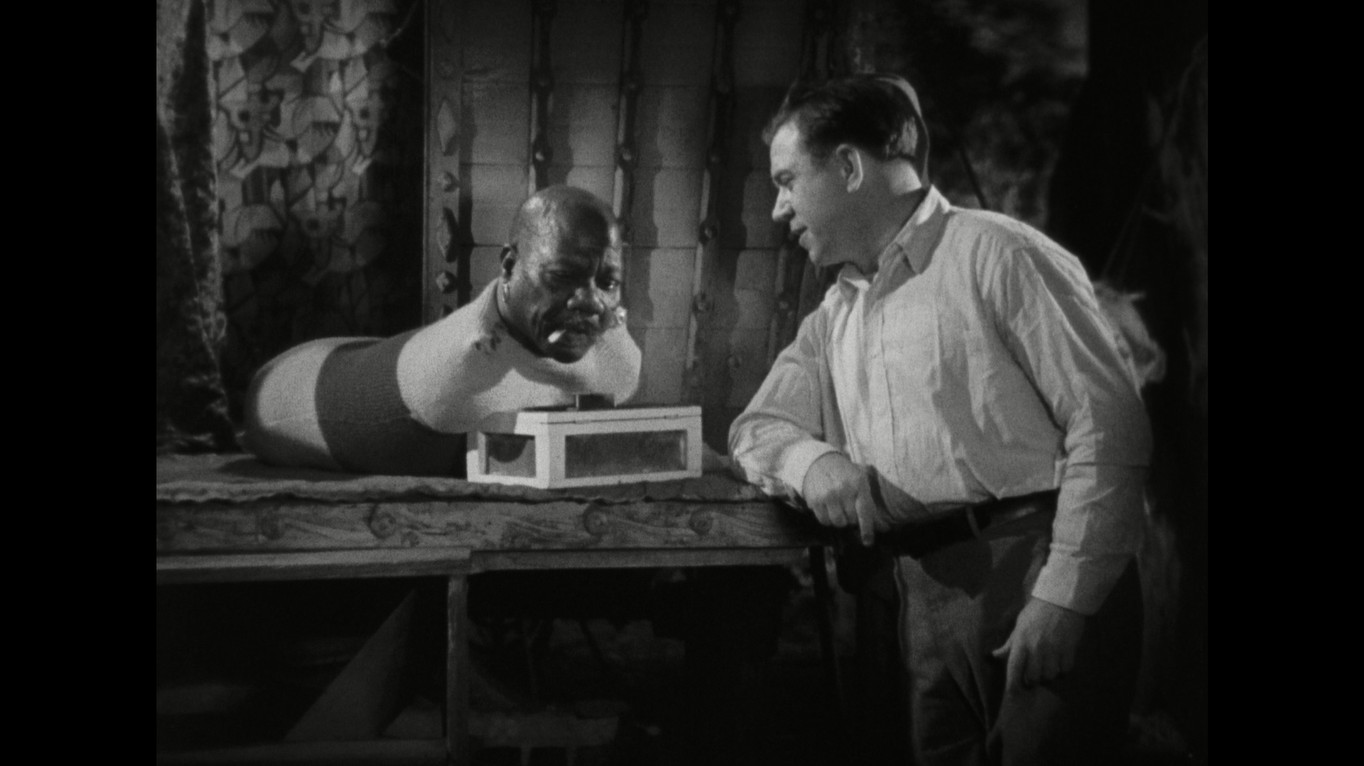
Though Tod Browning is now known as a horror film director, he cut his teeth on numerous melodramas and his version of Freaks was just as much a sordid soap. The plot is driven by the avarice and lust of individuals versus the mutual support of the community. We meet Venus (Leila Hyams) as she’s leaving the caravan of Hercules after discovering he’s been using her, mainly as a source of funds. She seeks comfort with the Phroso the Clown (Wallace Ford) who we learn has a good heart concealed beneath his 1930s brusque chauvinism. Yes, archetypes and stereotypes are employed to save time, but the freaks are shown as individuals, albeit still defined by their emphasised differences. They’re introduced in a series of vignettes that, unfortunately, give the impression of moving from one to another in a sideshow. Also, in the terrifying climax, some extra freaks we hadn’t met suddenly appear.
Significant screentime was devoted to several scenes of the freaks living their everyday lives, intending to illustrate their commonality rather than sensationalise their differences. Browning intended these threads to hold the movie together but alas, only fragments of the scenes survive after the original 90-minute print was hacked back to around 64.
We do spend some time with the ‘Living Venus De Milo’ (Frances O’Connor), who uses her legs and feet as dexterously as others would arms and hands to manipulate a knife and fork, smoke a cigarette, and sip from a wine glass. We follow the developing romances between the conjoined twins (Daisy and Violet Hilton) and their two able-bodied suitors in a few scenes played mainly for sauciness or smiles. And we share a sweet scene where the freaks assemble at the bedside of ‘The Bearded Lady’ (Olga Roderick) to congratulate her and ‘Human Skeleton’ (Peter Robinson) on the birth of their beautiful baby girl.
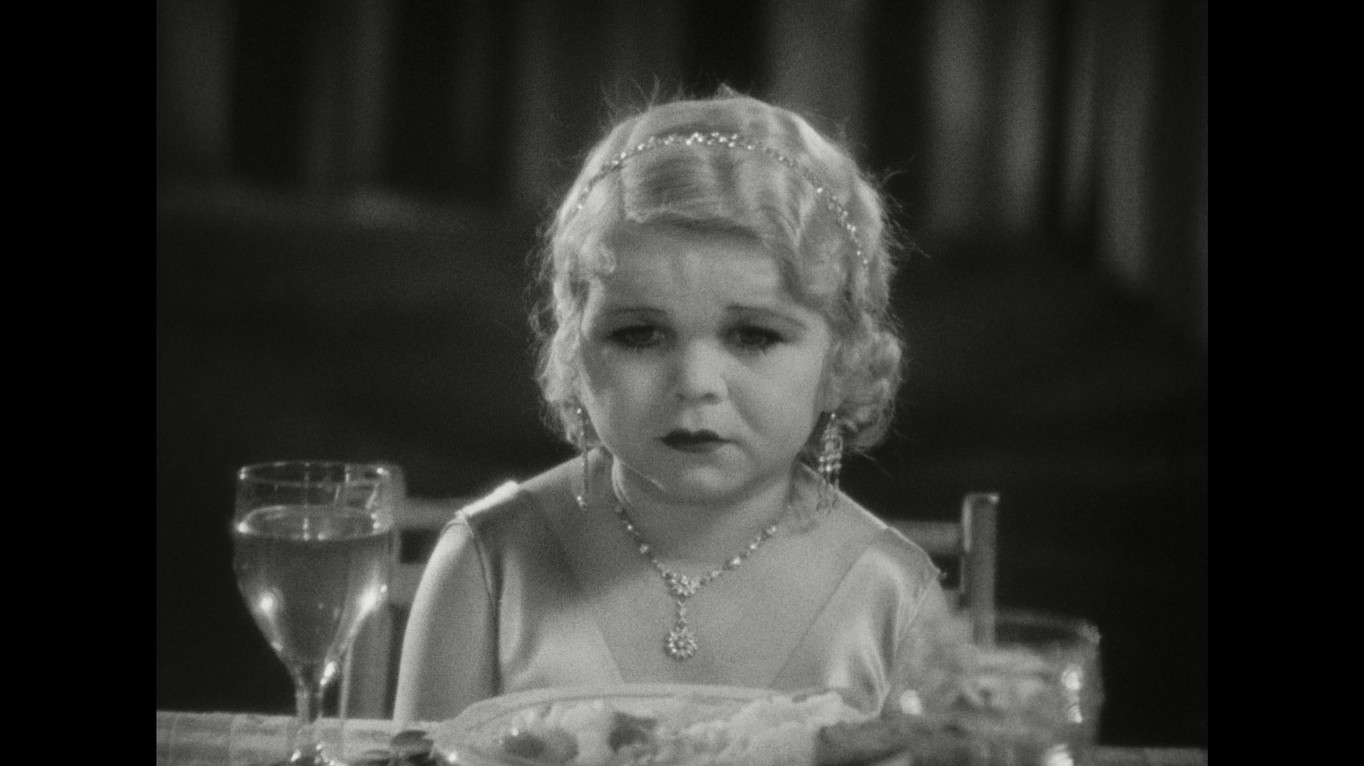
From his extensive experience working in circus, sideshows, and theatre, Tod Browning knew very well that exploitation was involved to various degrees. For the disabled of the day, there were few other available options. Due to stigma and lack of understanding, or purely logistical reasons, families often sold or gave their deformed children away. There weren’t many orphanages or organisations that could cater for their needs and sometimes selling them to a sideshow could be the best of an array of bad choices. Children with novel conditions had a future as performing ‘freaks’ and were often sold on to ‘carers’ in lucrative deals that brought the performer no additional benefits. A few compos mentis individuals managed to take control of their careers and could become major stars in their own right. The performers in Freaks represent both routes into the business…
It’s unlikely the three ‘pinheads’, who display microcephaly-related conditions, were given much choice in the matter, but Schlitzie was already a famous attraction and has been described as a ‘cultural icon’. Another androgynous person who used both masculine and feminine pronouns, they seemed to enjoy the travelling carnival life for when their ‘carer-manager’ died and Schlitzie was ‘retired’ to a hospital for the disabled they became withdrawn and increasingly depressed. Eventually, the hospital recommended they return to the sideshow life where they knew companionship and community.
Daisy and Harry Earles had a successful showbiz career as part of ‘The Doll Family’ and made their own business decisions. They earned enough to own houses and cars and to care for their siblings. Daisy and Violet Hilton, the conjoined twins, were also famous on the vaudeville and burlesque circuits, performing alongside the likes of Bob Hope and Charlie Chaplin, and at the time of Freaks were soon to be legally freed from care and guardianship at the behest of Harry Houdini. Their roles in the film, each with a suitor, are sadly ironic as in real life they’d applied for and were refused marriage licenses in more than 20 states, though both twins had ill-fated marriages later. Freaks was the high point of their career though they also appeared in the biopic Chained for Life (1952).
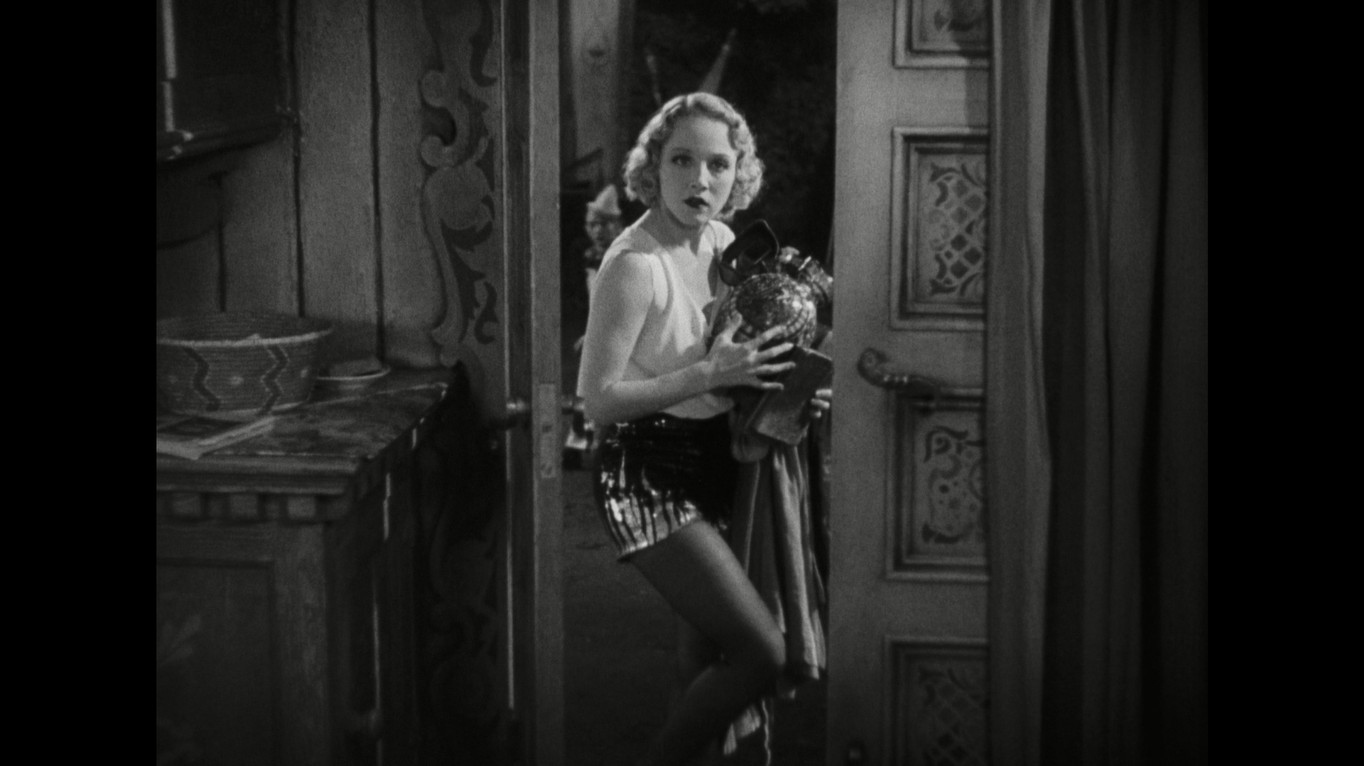
Prince Randian, ‘The Human Torso’, also enjoyed fame and made a living from his act that involved rolling and lighting cigarettes, shaving, and painting. There’s evidence that he married, owned a home, and fathered five children. Johnny Eck, billed as ‘Half-Boy’, had pursued a career in showbiz since the age of 12 when he signed up as a magician’s assistant and later toured a show with his brother, performing physical comedy, acrobatics, and stage magic. It’s said he enjoyed the world of filmmaking and became good friends with Tod Browning during the production. Olga Roderick, ‘The Bearded Lady’, was also there of her own accord though was one of the few cast members to speak disparagingly of the movie and the experience of making it.
Except for Daisy Earles, who turns in the most effective and affecting performance of all, the freaks are non-actors, but their roles aren’t demanding and rely on them playing themselves—so who can argue with that casting? It seems most of the professional actors are still wrestling with the transition from silent to talkies but the two female leads stand out. Leila Hyams was already a top Hollywood star, gracing the covers of numerous celebrity magazines. She appeared in more than 50 films over a decade beginning in the mid-1920s, typically playing lively, innocent-looking sexy blondes. So, her leading role in Freaks was a breeze for her.
Olga Baclanova had started on the stage of the Moscow Art Theatre and appeared in early Soviet ‘agitprop’ cinema before coming to the attention of Hollywood in her role as the tear-away Duchess Josiana in The Man Who Laughs (1928)—a similar role in which she uses her charms to toy with the affections of a vulnerable man. The prowess of that film’s director, Paul Leni, established much of the visual grammar of what would define the horror genre. Imported from his beginnings in German Expressionistic cinema the style was to inform and influence many Hollywood directors, Tod Browning among them.
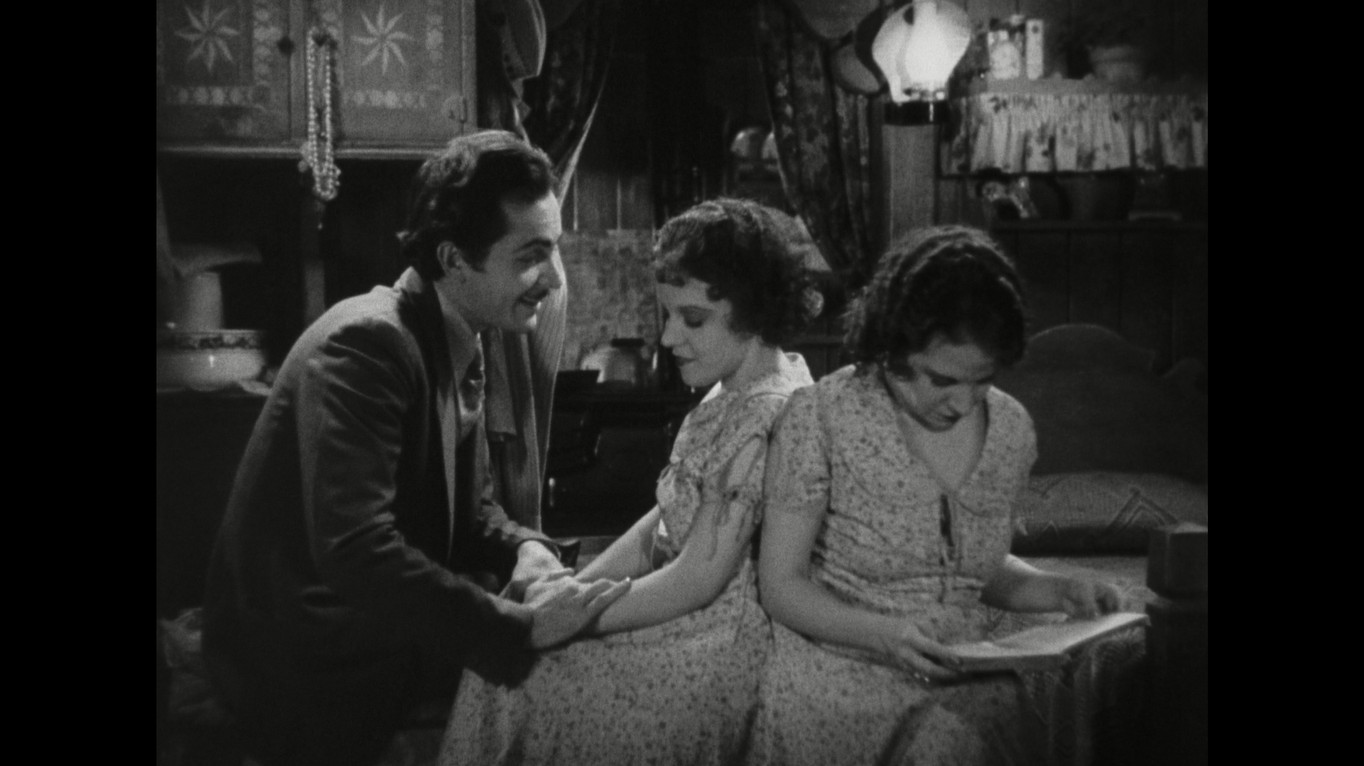
Only in the last five minutes does Freaks deliver the kind of cinematic flair one might expect from Browning, in a wonderfully staged sequence involving a convoy of circus caravans slaloming off a mud-slewed track in a freak lightning storm. Here, the imagery is genuinely nightmarish as the sideshow freaks (revealed in flashes of lightning) crawl and slip and swarm through muddy torrents, with murderous intent in their eyes. To add to the confusion, the scene was heavily edited to reduce the intensity of the horror, but to such an extent that the audience doesn’t get to see what ultimately happens. There’s something to be said for leaving things to the imagination. However, as it stands, the climax relies on the disturbing aspects of disabled and disfigured people rather than the dubious revenge they exact upon able-bodied ‘beautiful’ villains who are truly ugly on the inside.
From the continuity script and contemporary accounts, we know what the original ending looked like, and it made far more sense of the baffling reveal we’re left with. Perhaps I’m being too cautious by avoiding spoilers in a review of such a well-known, often discussed horror film, but the extras with this Blu-ray edition fill in the details of the original ending. It was an inspired fusion of discomforting dark humour and disgusting body horror, followed by an extended epilogue where we get to see the stories of several characters, good and bad, reach satisfying conclusions. MGM chose to deny us that.
Perhaps they should’ve trusted their director over unprepared test audiences who didn’t have a clue what they were in for. The film was a critical and commercial disaster, recording a total loss of $164,000. The controversy it stirred up didn’t help sell tickets and some states decreed it broke their laws—though I’m not sure what laws they were—and forbade cinemas from screening it at all. Like the film itself, its release was cut short. I’d love to see a reconstituted full-length Director’s Cut with all the missing scenes replaced by animation and narration. Perhaps this would be a legitimate challenge for artificial intelligence.
Browning found it hard to make movies after that. For fear of the stigma left by the freak failure, studios were reluctant to credit him for his next two films, Fast Workers (1933) and The Devil Doll (1936). He was credited with only two more movies, a follow-up to Dracula again starring Bela Lugosi, this time as Count Mora, in Mark of the Vampire (1935), and a murder mystery set in the world of con-men and fake mediums called Miracles for Sale (1939).
USA | 1932 | 64 MINUTES | 1.37:1 | BLACK & WHITE | ENGLISH • GERMAN • FRENCH
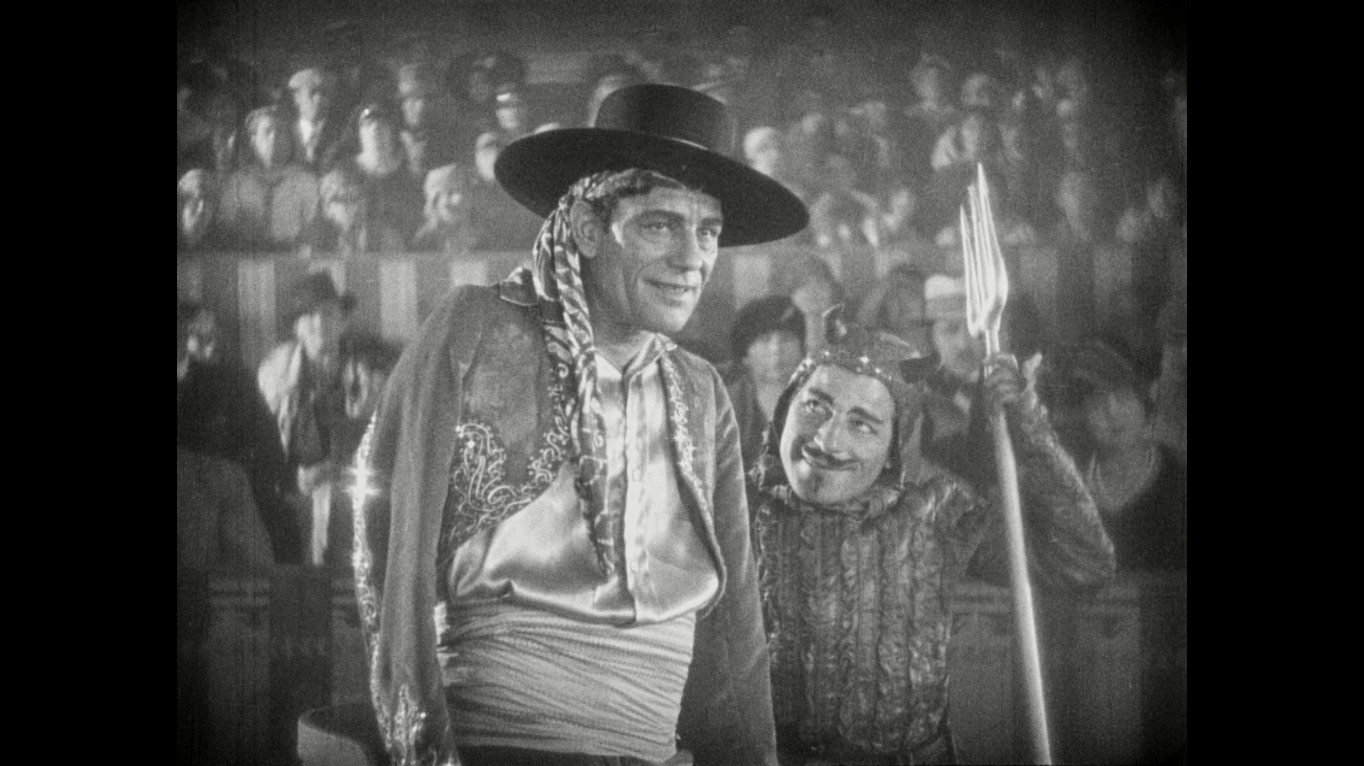

A criminal on the run hides in a circus and seeks to possess the daughter of the ringmaster at any cost.
Another Tod Browning film set among circus folk, this time featuring his muse, Lon Chaney as a ‘gaffed freak’—or at least he is to start with. A gaffed freak is a person faking unusual features to attract a sideshow audience. In this case, Alonzo is an armless knife-thrower and sharp-shooter who uses dexterous toes instead of fingers. He keeps his arms concealed, tightly strapped down in a corset-style contraption. But why? No one knows his dark secret except his confidant, Cojo (John George), the circus dwarf who dresses up as a little devil for his act.
After a brief preamble telling us what we’re about to see is based on a true story (which it isn’t), the film opens with Alonzo’s most popular act. Aiming and firing a rifle with his feet, he shoots at his assistant, the ringmaster’s beautiful daughter Nanon (Joan Crawford). Each shot snips a strap on her gipsy outfit until it falls away, leaving her wearing only shorts and a skimpy top (an early bikini, long before they were known as such). Pretty risqué for the era, but that’s not all… for the second part of the act, Alonzo throws knives with his feet, narrowly missing Nanon on her moving platform. There’s an unmistakable sexual frisson between Alonzo and Nanon, to which Browning adds the symbolism of piercing knife blades and phallic connotations of a rifle fired from ‘between the legs’.
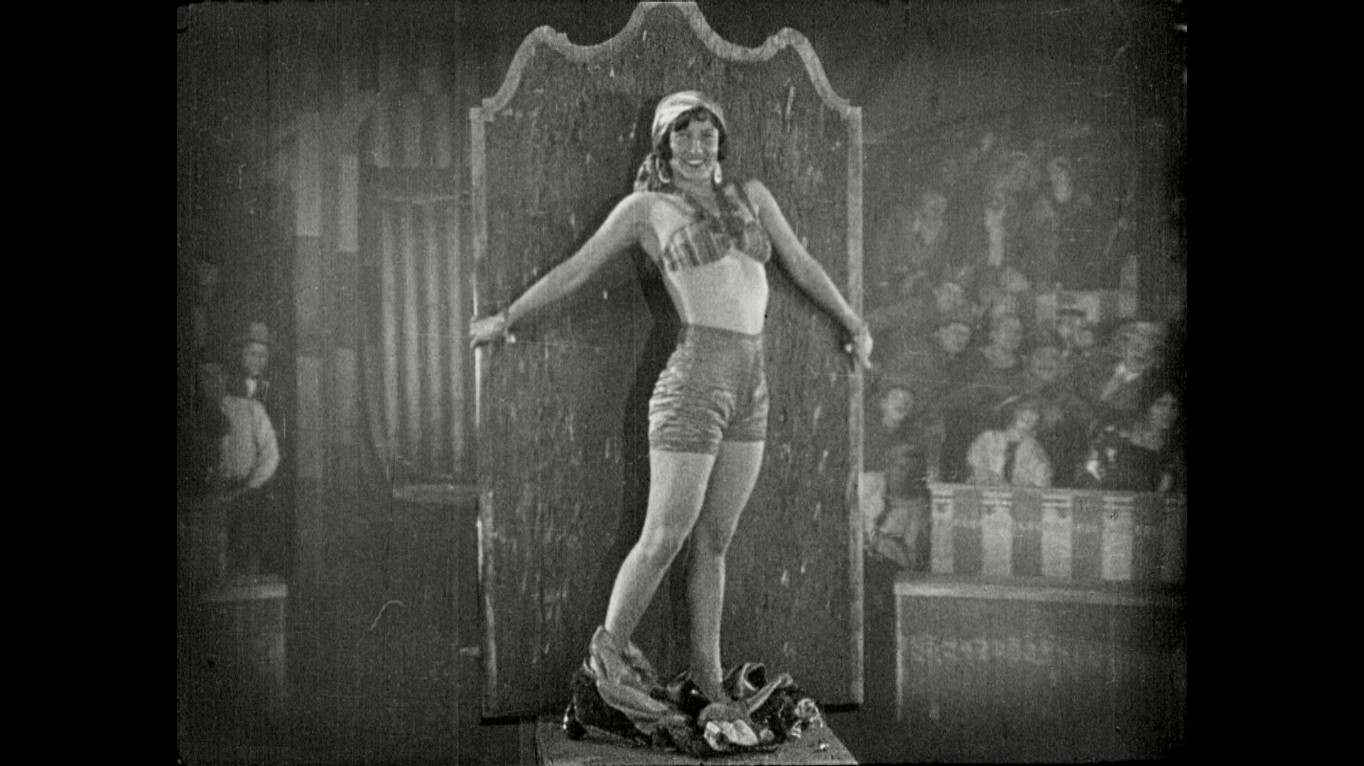
Although it’s all bubbling under, there are some powerful psycho-sexual subtexts in a beautifully contrived tale of passion, perversity, and deadly obsession that proves to be a gruelling but completely absorbing experience. It turns out Nanon bears the psychological scars of some trauma that causes her to feel revulsion at the touch of a man’s hands. The implication is that she’s been raped, possibly by her father, and can no longer trust any man except her friend and protector, Alonzo. After all, without arms, he cannot paw her, grab her, or hold her down against her will. However, her brutish father (Nick De Ruiz) won’t tolerate her spending time in Alonzo’s quarters. Catching her there, he throws her out and cruelly beats Alonzo, who bravely puts up some resistance while Cojo runs to get help from the strongman, Malabar the Mighty (Norman Kerry), who breaks up the brawl.
In the aftermath, we learn that Malabar is a well-meaning ‘gentle giant’ with a crush on Manon—and it’s here, too, that Alonzo reveals his mean streak. Thanking Malabar for his intervention, he praises his strength and suggests that he should step up as Nanon’s protector encouraging him to take her in his strong arms to prove how powerful and capable he is, knowing full well what her reaction will be.
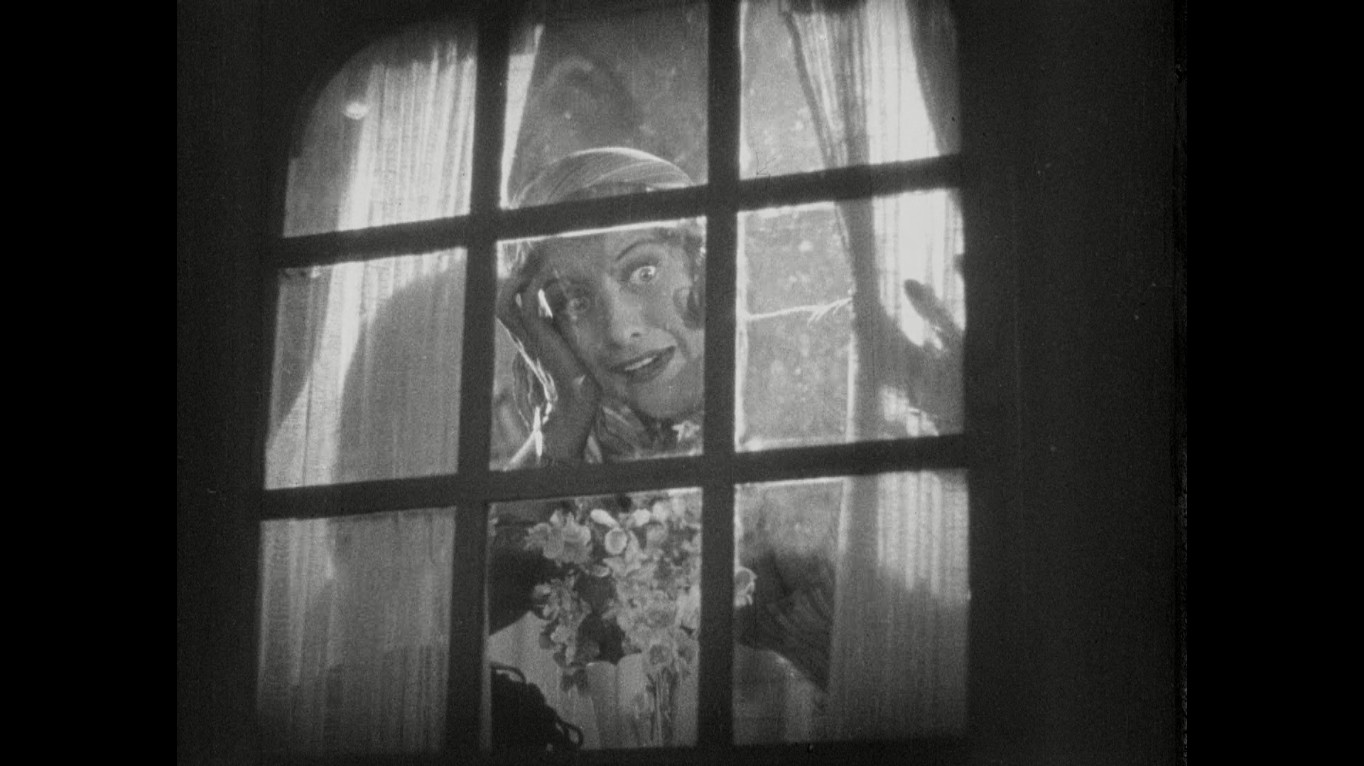
The interaction reveals Alonzo’s deep personal conflict. He also wants to possess Nanon but knows that should they become intimate as he hopes, she’ll discover his hidden appendages and realise his deception. He fears that she would then lose all trust in him, as well hate him for his man-hands. From hereon, both men take vastly different approaches to wooing her…
Later that night, Nanon is drawn to her window by a commotion below and witnesses a brutish figure beat down and throttle her father to death. She cannot see the assailant’s face but notes their distinctive hand with its double thumb. Early on, we get the reveal that Alonzo is a wanted criminal, incognito, hiding his distinctive hands that would give him away and link him to unspeakable crimes committed in his past.
For me, this is the strongest of the three movies collected in this new Criterion Blu-ray box set and, as this is the first digital release of this sensitively restored print, I’ll give no more away. Except to say we skirt similar psychological territory as Lon Chaney’s Phantom of the Opera (1925) and Robert Wiene’s The Hands of Orlac (1924), starring Conrad Veidt, which may have provided part inspiration for Browning’s equally intense and perversely poetic Grand-Guignol piece. The films would make for a great double bill as they showcase the talents of the two greatest actors of the silent age. And both deal with deep Freudian subtexts of gender identity and symbolic emasculation… as does Freaks.
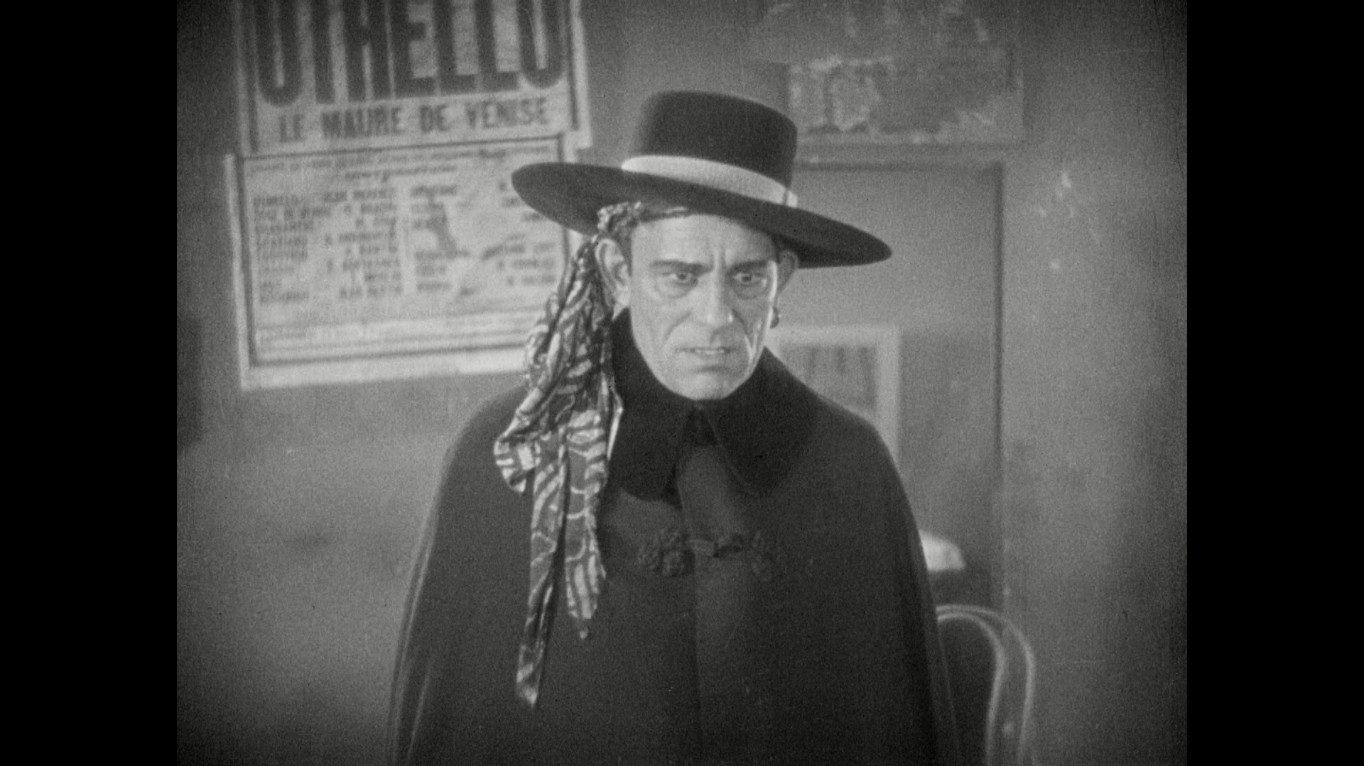
Lon Chaney’s performance in The Unknown is as astonishing as ever and, more than once, he showcases his ability to shift through a tangled set of emotions in a single shot, using only expressions and posture. Somehow, he makes it clear when anguish morphs into anger, regret into rage. This is doubly impressive when one considers he’s acting with his arms strapped tightly for around 5-hours a day, and with another man’s legs wrapped around his waist for much of the time.
Talented as Chaney was, he couldn’t train himself to use his feet so expertly. The foot action is provided by a second actor, Paul Desmuke, who was a genuine circus performer without arms who could shoot rifles and throw knives with his feet. His abilities were the deciding factor in what act Alonzo performed and it’s thought the idea of an armless character at the initial scripting stage was inspired by him.
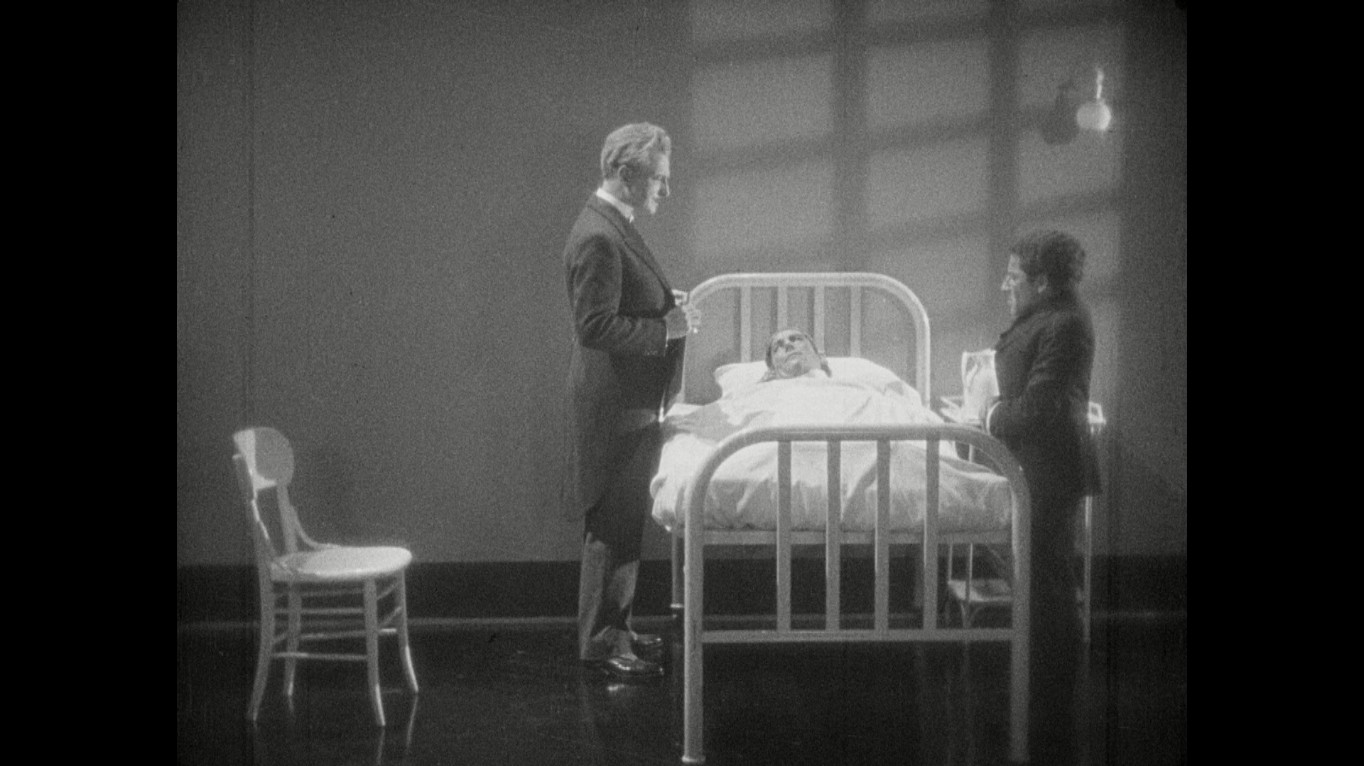
Joan Crawford, who was just 18 at the time, later said that acting opposite Chaney taught her more about the craft than any other experience of her whole, five-decade-spanning career. Norman Kerry is also fine sharing the male lead and had already worked with Chaney a couple of times, in The Hunchback of Notre Dame (1923) and The Phantom of the Opera.
The Unknown is a simple but expertly crafted psychological thriller that pushes its gruesome themes to the boundaries of horror. What the narrative may lack in complexity, it more than makes up for with emotional intensity. As far as performances go, this must rank among the very best of Lon Chaney, and as for direction, Tod Browning is never better.
So, it’s fantastic that this lost masterpiece was found and rebuilt from the only two prints known to have survived. The first incomplete version, running for 49 minutes, was found in the archives of Cinémathèque Française among countless canisters containing ‘unknown’ footage, where it had been mistakenly stored for decades. A second, nitrate distribution print was later found in a Czech archive and footage from both prints was assembled and restored to create the most complete version presented here. The quality varies and some scenes appear to have been shot through a heavy gauze, but the overall, poetic and painterly effect is very beautiful.
USA | 1927 | 63 MINUTES | 1.33:1 | BLACK & WHITE | ENGLISH
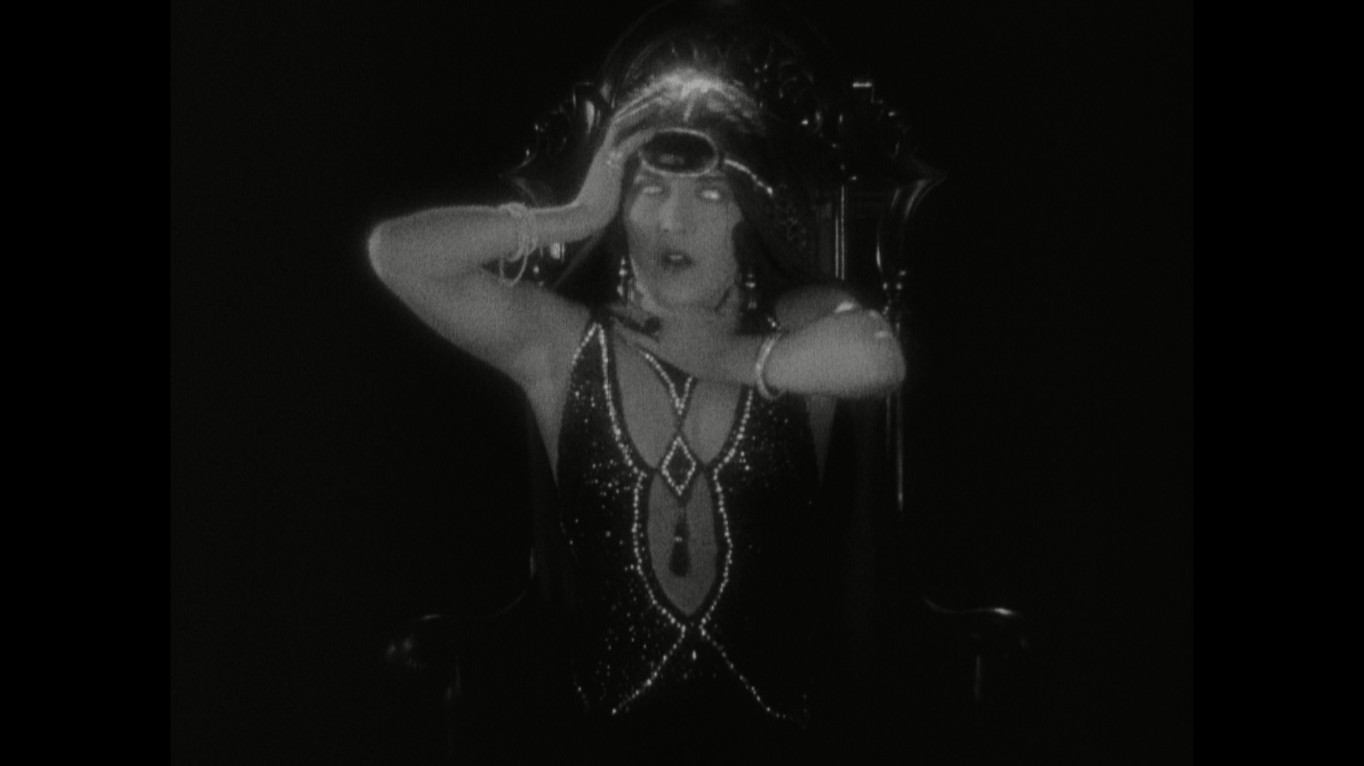

An American criminal imports a gang of Hungarian gipsies to gain control over a fortune…
We remain in familiar Browning territory with the third and oldest film presented here. The Mystic is the most accomplished in terms of crowd-pleasing cinema with a solid character-driven story that keeps one guessing till the end. It’s a fusion of melodrama, mystery, crime caper, and supernatural thriller. It can be argued that Browning is the director who pushed the strange and supernatural into the mainstream with Dracula, though most of his earlier films dealing with the theme were a bit ‘Scooby-Doo’—where the mysterious events are faked by scheming criminals trying to divert attention or cover something up.
The Mystic begins at a travelling gipsy carnival as Anton (Robert Ober) nonchalantly snacks while practising his knife-throwing act with Zara (Aileen Pringle). Her father and show-runner, Zazarack (Mitchell Lewis), admonishes him for being so careless and endangering her. To prove she’s in safe hands, Zara holds up a sausage as a target for Anton who deftly chucks his final knife, neatly slicing off its end. Her father is so traumatised by this that he gestures irately, shaking his beer bottle so a plume of foam sprays comedically over him. It’s not too hard to unpick that silly and not-so-subtle Freudian symbolism. But don’t worry, that almost slapstick moment is not representative of the film, which is by no means a comedy, but does lighten the mood compared to the other two titles here.
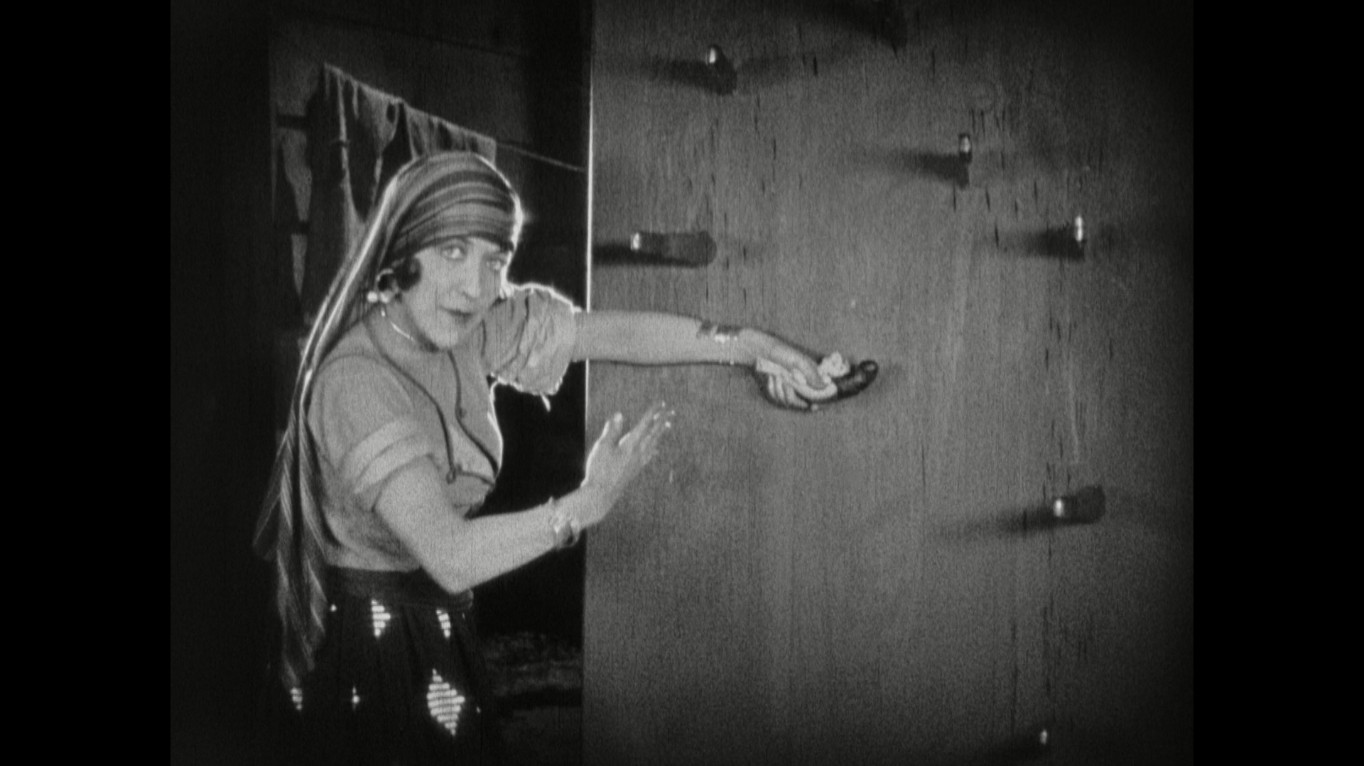
We stay with the carnival as Zara performs her psychic act where two men from the audience are invited onstage to blindfold and bind her to a chair. As soon as the curtain falls around her, however, the spirits release her from bondage. We see that what really happens is Anton reaches up through a hatch and cuts her ties. From the stage, she notices a distinctive man in the crowd who’s followed the travelling carnival from the last town and the three gypsies become suspicious of his intentions. The stranger, who appears to have stepped out of a noir thriller with a suit, trilby, and dramatically lit smoke curling from a cigarette, approaches Zara on the pretence of being an admirer. Anton’s jealousy is aroused—another infatuated knife-wielding carny. After a brief scuffle, the stranger reveals himself as Michael Nash (Conway Tearle) a conman who wants to pay for their tickets to take their show to the US and help him con a young heiress out of her inheritance. Being stereotypically unscrupulous carnival folk, they’re totally up for that.
Over in the US, they stage elaborate shows involving Zara channelling the spirits of the dead and Anton manifesting their presence using clever deceptions. The demystification of methods used by fake mediums would probably have been a service as such showy spiritualism was indeed popular at the time. However, the gang attract the attention of the local police commissioner (DeWitt Jennings) who is on the trail of a clever crook who has thus far eluded capture by manipulating others to take the fall for him. Sure enough, Nash is manipulating the trio of imported carnival performers to ply their deception for increasingly high stakes and it’s not long until they get wise to his masterplan and what a bigger cut, of course.
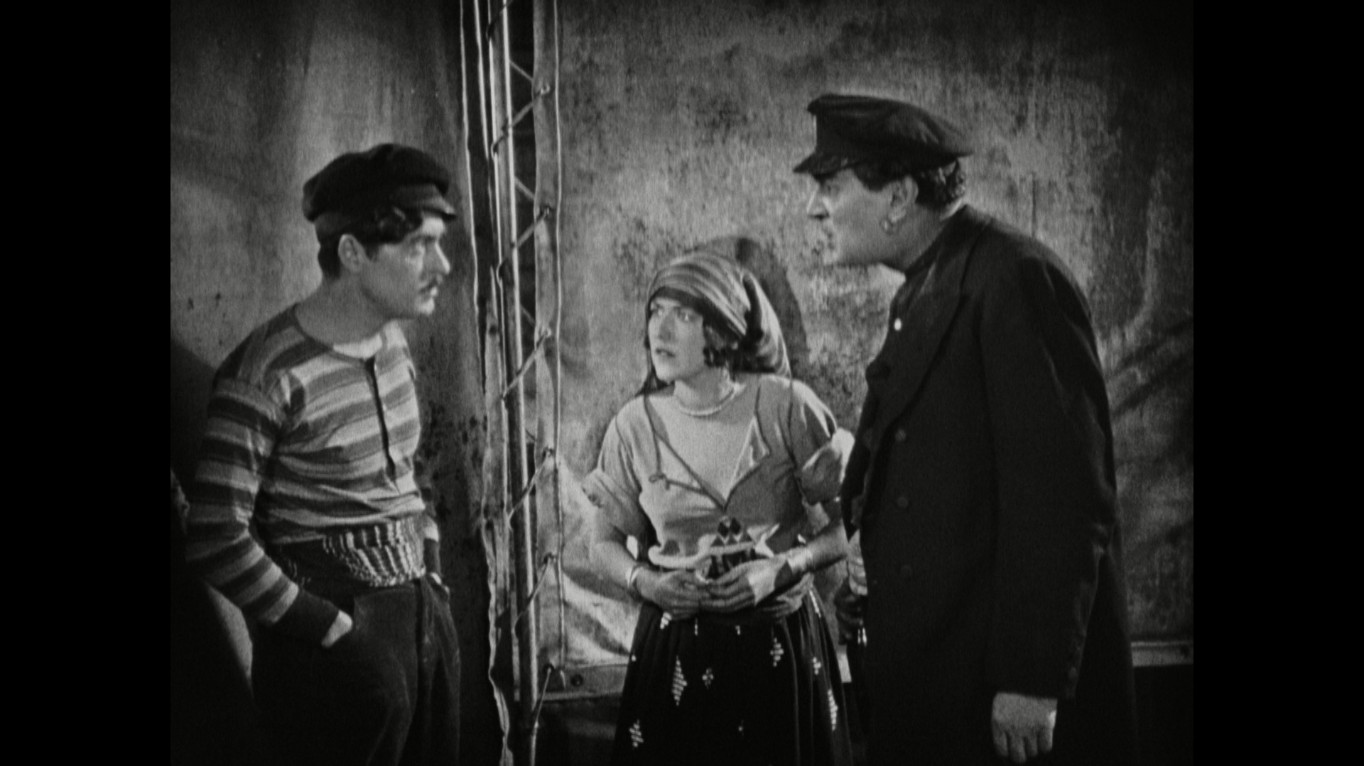
Their main target is Doris Merrick (Gladys Heulett) who stands to inherit a fortune but is influenced by fake messages from her dead father, to move a fortune in jewels from one safe place to another, keeping them at home for a night as they are transferred. By this time things have become complicated. The fake psychic has been found out and others are using the same scam to introduce conflicting messages. The love triangle between Zara, Anton, and Nash, has developed into a love rectangle with the introduction of Dorris… perhaps even a love pentagon if one includes the love of money! Who will betray who?
The unravelling of the neatly set-up plot is unpredictable yet convincing and the character turnarounds are masterfully handled. The cast are all competent, seasoned actors, with Conway Tearle’s wonderfully expressive face stealing several scenes. It may be a bit slow – and silent – by today’s standards, but it’s a thoughtful meditation on the nature of transactional human relationships, the value of trust, and redemption. Entertaining throughout, the ending is satisfying and by no means as tragic as the finales of Freaks or The Unknown… but that would be difficult!
USA | 1925 | 74 MINUTES | 1.33:1 | BLACK & WHITE | ENGLISH

Of course, for films of this age and condition, even 2K could be considered overkill but in many ways essential to preserve such classics in the best possible condition and higher than original resolution to arrest their further decay. The picture quality is as good as can be given the surviving source material and the damaged portions of the the older movies, particularly in The Unknown have a beauty all their own. The dialogue track for Freaks has been cleaned up nicely with very little noise. The new scores for The Mystic and The Unknown both sound great.

director: Tod Browning.
writers: Tod Browning, Clarence Aaron ‘Tod’ Robbins (Freaks), Willis Goldbeck (Freaks), Leon Gordon (Freaks), Waldemar Young (Mystic, Unknown) & Joseph Farnham (Unknown)
starring: Wallace Ford, Leila Hyams & Olga Baclanova • Lon Chaney, Norman Kerry & Joan Crawford (Unknown) • Aileen Pringle, Conway Tearle & Mitchell Lewis (Mystic).
